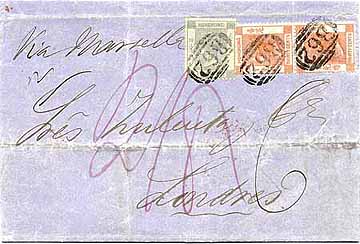| USE
OF HONG KONG STAMPS ON PHILIPPINE MAIL
Hong
Kong Adhesives
When
Hong Kong first issued adhesives on December 8, 1862, the use of these
adhesives was optional in Hong Kong and the Treaty Ports Postal Agencies.
Their use became compulsory on mail posted at Hong Kong from February 16,
1864, and in the Treaty Ports from October 16, 1865. Observed usage of
the Hong Kong adhesives at Manila seems to be consistent with the regulations
applying to the Treaty Ports.
The
latest known stampless letter from Philippines via Hong Kong is dated October
1864. The earliest known use of Hong Kong adhesives on mail from the Philippines
is on a letter to Boston, with a Hong Kong date-stamp of April 25, 1865.
I know of seven 1865 covers from Manila with Hong Kong
adhesives.
Hong
Kong adhesives were used on mail from the Philippines, that traveled via
Hong Kong. This continued until 1877 when the Philippines joined the Universal
Postal Union, and its own adhesives became valid for postage to all member
countries.

Figure
1: 1870 (October 25) Manila to London. Only known Philippine cover carried
on emergency Brindisi route, when the Franco-Prussian War closed the endorsed
route via Marseilles. The recipient paid an extra 6 pence (black manuscript
6) for the new route
After
1872, there was a regular steamer service between Manila and Singapore,
so mail to Europe no longer went via Hong Kong. Hong Kong adhesives were
still used on mail from the Philippines to Hong Kong, and to the United
States traveling across the Pacific.
The
Hong Kong adhesives were denominated in cents, 100 to a dollar. The history
of this currency involves the Philippines. For two and a half centuries,
there was a Galleon trade between Manila and Acapulco in Mexico. As a result,
there was a large number of Mexican silver pesos in circulation in Hong
Kong and China. The Hong Kong dollar started as the Mexican silver dollar.
It had the same monetary value as the dollar of the United States of America.
The exchange rate with the British currency was simple, namely one penny
equal to 2 cents.
Manuscript
markings expressing the British currency occur on all covers with Hong
Kong adhesives up until the early 1870s, whether the cover originated in
Hong Kong, Philippines, or elsewhere. For example, FIGURE I has 64 cents
adhesives, and manuscript 2/8 for 2 shilling 8 pence, equal to 32 pence.
I believe these manuscript markings were applied in Hong Kong. Some references
state that the manuscript was applied in Britain, but this cannot be the
case as these markings are found on letters addressed to European countries
that did not pass through Britain. The Hong Kong Post Office maintained
its accounts in sterling, so I believe this was some form of internal accounting,
possibly with the British Post Office. The manuscript is also a useful
check that the correct adhesives are still in place. For example,
there is a Manila cover with a manuscript of 2 shilling 8 pence, yet it
only bears a 48 cent adhesive.
The
cover in FIGURE I is very interesting for both its route and rate. It is
franked with 64 cents, the rate to Britain via Marseilles for a letter
between half and one ounce. Due to the 1870 Franco-Prussian War, the Marseilles
route was closed, and mail was sent via Brindisi in Italy, and through
Brenner Pass, Munich, Cologne and Ostende. There was a higher rate of 3
pence per half ounce. However, for two months, senders of mail from Asia
and Australia were unaware of the new rate, and the British Post Office
only charged the recipient with the deficiency of postage rather than a
fine. The recipient of this double letter paid the additional 6 pence. |

